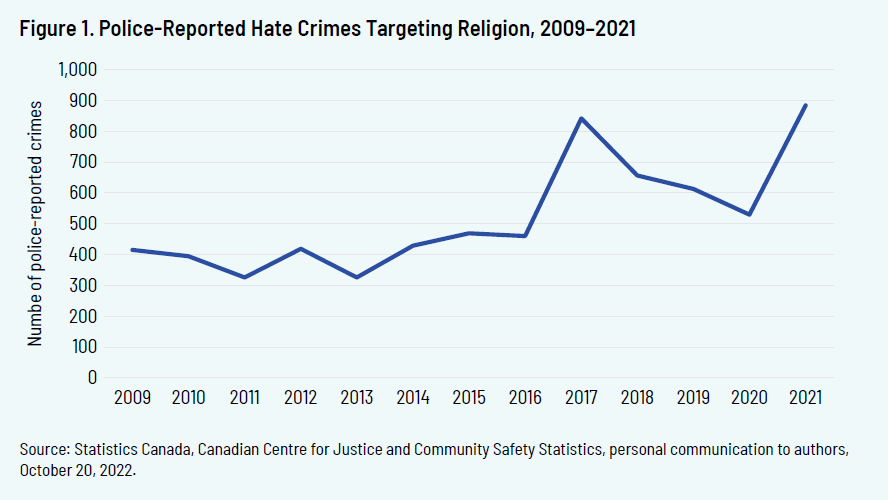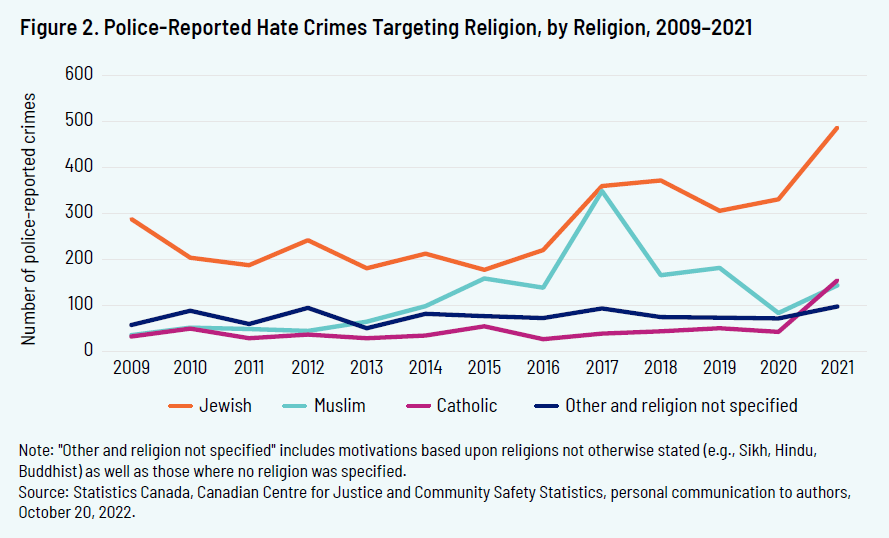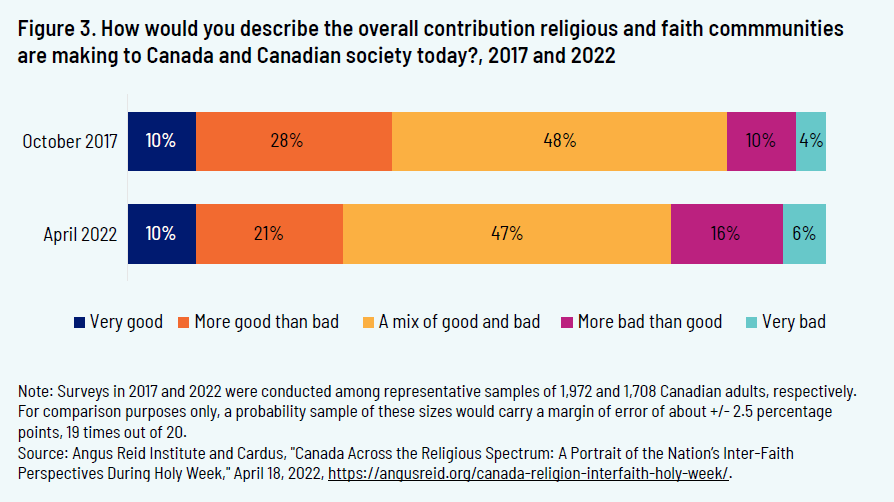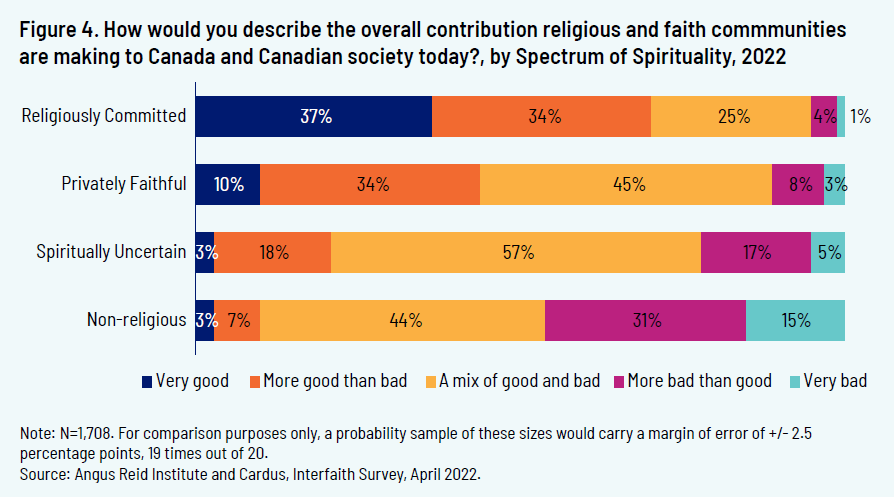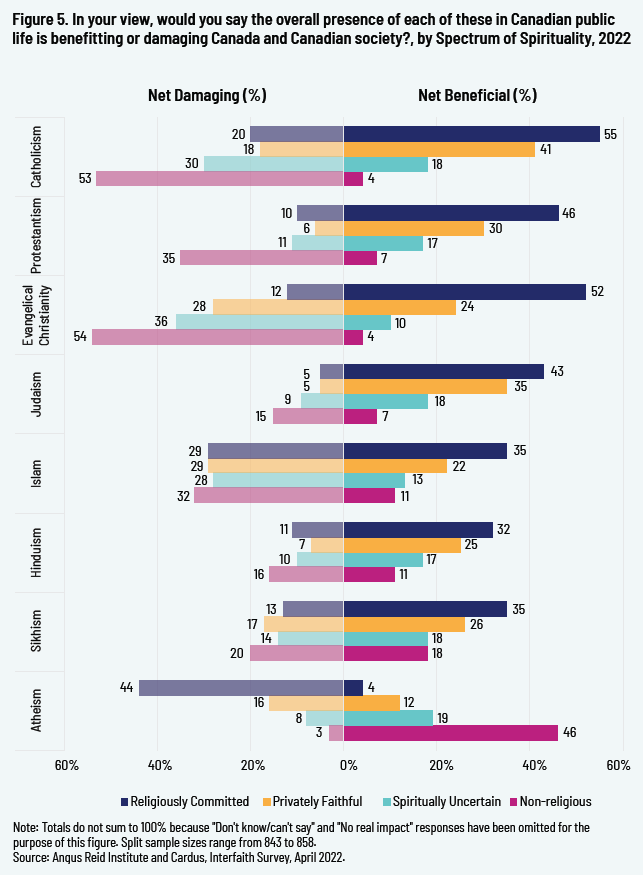Table of Contents
Table of Contents
Introduction
A Muslim mother attacked and called a “terrorist” while picking up her children from school. 1 1 “‘Frightening’ Attacks Leave Ontario Muslims Shaken,” CBC, November 17, 2015, https://www.cbc.ca/news/canada/toronto/frightening-attacks-leave-ontario-muslims-shaken-1.3323107. Graffiti near university campuses calling for Jews to be killed. 2 2 M. Starr, “‘Kill the Jews’ Graffiti, Swastika Found Near Queen’s University Campus,” Jerusalem Post, October 27, 2022, https://www.jpost.com/diaspora/antisemitism/article-720720; M. Starr, “‘Shoot a Jew in the Head’ Graffitied Near Toronto University,” Jerusalem Post, June 13, 2022, https://www.jpost.com/diaspora/antisemitism/article-709269. A Hindu family conducting a peaceful ceremony at a Mississauga park, assaulted by two teenagers and having to flee in their car. 3 3 D. Finucane, “Man and His Family Victims of Hate Crime at Mississauga Park,” Insauga, September 13, 2021, https://www.insauga.com/man-and-his-family-victims-of-hate-crime-at-mississauga-park/. A synagogue in Guelph, vandalized with images of Adolf Hitler. 4 4 A. Sandstrom, “Images of Hitler Affixed to Guelph, Ont. Synagogue Door, Police Say,” CTV News, October 11, 2022, https://kitchener.ctvnews.ca/images-of-hitler-affixed-to-guelph-ont-synagogue-door-police-say-1.6104316. Dozens of Christian churches vandalized or burned, including some on reserves and counting Indigenous families among their members. 5 5 C. Rousselle and J. Bukuras, “Indigenous Leaders Condemn Recent Vandalism of Churches in Canada,” Catholic News Agency, June 29, 2021, https://www.catholicnewsagency.com/news/248185/indigenous-leaders-condemn-recent-vandalism-of-churches-in-canada; C. Dzurdzsa, “Update: A Map of the 71 Churches That Have Been Vandalized or Burned Since the Residential Schools Announcement,” True North, August 23, 2021, https://tnc.news/2021/08/23/a-map-of-every-church-burnt-or-vandalized-since-the-residential-school-announcements/.
These are just some of the recent incidents that are confirmed or suspected of being motivated by anti-religious animus in Canada. And others have even resulted in loss of life: The Afzaal family was out for an evening walk in London, Ontario when they were run over by a man driving a truck—targeted, authorities believe, because they were Muslims. Of the five family members stretching across three generations, only the youngest, a nine-year-old boy, survived. 6 6 Associated Press, “A Man Ran Over a Muslim Family with His Truck Because of Their Religion, Police Say,” NPR, June 8, 2021, https://www.npr.org/2021/06/08/1004304899/man-ran-over-muslim-family-truck-canada-london-afzal. And in January of 2017, a shooter entered a Quebec City mosque where dozens had gathered for evening prayers and opened fire, killing six and wounding several others. 7 7 R c Bissonnette, 2019 QCCS 354 (CanLII), https://canlii.ca/t/j1672.
Such incidents are deeply disturbing to us all. No one should be made to feel unwelcome because of their religious faith, and certainly not to the point of losing one’s life. To live out one’s faith in freedom and security is one of the hallmarks of liberal, pluralist democracies. The Canadian Charter of Rights and Freedoms constitutionally guarantees the fundamental freedom of conscience and religion, and religion is one of the protected categories under the Canadian Human Rights Act. 8 8 Canadian Charter of Rights and Freedoms, Part 1 of the Constitution Act, 1982; Canadian Human Rights Act, RSC. 1985, c. H-6. We can see the importance of these laws with painful clarity when a faith community or its members or property becomes the target of criminal activity because of their faith: that is, when they are victims of religious hate crimes.
What Is a Hate Crime?
The Criminal Code criminalizes “advocating genocide” and “publicly inciting hatred,” but the term “hate crime” does not itself appear in the Code. 9 9 Criminal Code, RSC 1985, c C-46, s. 318–319. The Uniform Crime Reporting Survey (UCR), operated by the Canadian Centre for Justice and Community Safety Statistics, which is part of Statistics Canada, defines a hate crime as “a criminal violation [that police have deemed to be] motivated by hate, based on race, national or ethnic origin, language, colour, religion, sex, age, mental or physical disability, sexual orientation or any other similar factor, such as profession or political beliefs.” 10 10 The UCR definition of hate crimes includes incidents that are strongly “suspected” and “confirmed” to be motivated by hate, bias, or prejudice. Suspected hate crimes are criminal violations with sufficient evidence for police to reasonably believe they are motivated by hate, but cannot be confirmed as such (e.g., hate graffiti where no accused is identified). Statistics Canada, “Uniform Crime Reporting Survey (UCR): Variable(s),” last modified August 3, 2022, https://www23.statcan.gc.ca/imdb/p2SV.pl?Function=assembleDESurv&DECId=244139&RepClass=591&Id=1405282&DFId=244073. In other words, hate crimes are not a distinct kind of crime but rather a crime with a distinct kind of motivation toward victims with perceived characteristics or identity markers.
Although the term “hate crime” does not appear in the Code, if a suspect is convicted of a crime, the sentence can be lengthened if the court determines there is “evidence that the offence was motivated by bias, prejudice or hate based on race, national or ethnic origin, language, colour, religion, sex, age, mental or physical disability, sexual orientation, or gender identity or expression, or on any other similar factor.” 11 11 Criminal Code, RSC 1985, c. C-46, s. 718.2(a)(i). The Criminal Code also specifies that a conviction for damage to property used for religious worship or used primarily by an identifiable group can receive a longer sentence if the activity was “motivated by bias, prejudice or hate based on” a similar set of identity markers. 12 12 Criminal Code, RSC 1985, c. C-46, s. 430(4.1).
For the purposes of this brief, Cardus relies on the UCR definition of hate crimes for reporting the number of religious hate-crime incidents in Canada. The UCR has collected summary data since 1962 and more detailed incident-based data since 1988. 13 13 Statistics Canada, “Uniform Crime Reporting Survey (UCR),” last modified August 3, 2022, https://www23.statcan.gc.ca/imdb/p2SV.pl?Function=getSurvey&SDDS=3302. Hate crime was introduced to the UCR as a separate variable in 2004, and the survey was modified the following year to collect the more detailed data of which particular community or category was targeted. 14 14 J.H. Wang and G. Moreau, “Police-Reported Hate Crime in Canada, 2020,” Statistics Canada, March 17, 2022, https://www150.statcan.gc.ca/n1/pub/85-002-x/2022001/article/00005-eng.htm. However, since this information was first collected as part of a pilot study, the earliest year for which comparable data are available is 2009.
In 2021, about two hundred police forces, collectively serving 99.7 percent of Canada’s population, sent data to the UCR, making it a very accurate measure of crimes reported to the police in Canada, but it is important to remember that not all crime is reported to or comes to the attention of police, and only those crimes that police deem are motivated by hate are reported on the UCR. Therefore, the number of incidents in the UCR may not reflect the actual number or extent of hate crimes committed in Canada. 15 15 Given the variability in reporting practices and the impact of legislative influences on the UCR, year-over-year data comparisons should be interpreted with caution.
Trends in Religious Hate Crimes
In 2009, the first year for which comparable data are available, 415 hate crimes targeting religious persons or communities were reported by police services. After fluctuating within a narrow range for several years, the number began to rise, reaching 842 incidents in 2017. 16 16 Statistics Canada, Canadian Centre for Justice and Community Safety Statistics, personal communication to authors, October 20, 2022. The number has again fluctuated since 2017 but remains at a historically elevated level. In 2021, hate crimes targeting religious communities reached their highest point since 2009, with nearly 900 such crimes (figure 1).
Consistent with previous years, the most-targeted group in 2021 was the Jewish community, which since 2009 has experienced more hate crimes than all other faith groups combined. These crimes averaged nearly 350 per year from 2017 to 2020 and surged to nearly 500 in 2021. Hate crimes targeting Muslims also saw a significant jump from 2016 to 2017. Muslims across the country were the targets of nearly 350 hate crimes in 2017—almost enough to total one incident every day of the year.
The largest spike in 2021 relative to previous years, however, occurred against Catholics: from 43 in 2020 to 155 in 2021 (figure 2). The spike coincided with news reports about possible unmarked graves at former residential schools, many of which were run by Catholic religious orders or Christian churches. Since these news reports, over seventy churches across the country have apparently been vandalized or burned in suspicious circumstances.
Shifting Attitudes Toward Religion and Faith Contributions
The rise of religious hate crimes is occurring against a backdrop of increasingly negative public attitudes toward the contributions of religion and faith communities to Canada. Majority opinions are not necessarily linked to hate crimes, of course—only a tiny fraction of Canadians commit hate crimes. Yet it is reasonable to assume that those who are accused of religious hate crimes may be emboldened by a declining respect for or acceptance of religion and religious persons. Over the past five years, Cardus has collaborated with the Angus Reid Institute to study Canadians’ religious beliefs and practices and their views toward other faiths and atheism. This polling has found that while the proportion of Canadians who say that the overall contribution of religion and faith communities is a mix of good and bad has remained steady since 2017, at just under 50 percent, those who say that the bad outweighs the good has increased from 14 percent to 22 percent (figure 3).
Negative attitudes about the contributions of people of faith and religion are more concentrated among Canadians who are themselves Non-religious (a term assigned as part of the Spectrum of Spirituality Index—see sidebar). Among respondents who are Non-religious, almost half (46 percent) believe that faith communities’ contributions to Canada and Canadian society are mostly negative. In contrast, Canadians who identify with a religion are overall more likely to see the presence of all religions in public life, not just their own religion, as benefitting the country as a whole. 17 17 R. Pennings and J. Los, “The Shifting Landscape of Faith in Canada,” Cardus, 2022, https://www.cardus.ca/research/spirited-citizenship/reports/the-shifting-landscape-of-faith-in-canada/. Around seven in ten of those categorized as Religiously Committed view faith communities’ contributions as a net good (figure 4).
In decades past, some Canadians who identified as religious harboured animosity toward those who followed a different faith. Anti-Catholic sentiment occurred within some Protestant communities, for example. Today the situation is different. The polling suggests that the primary division in attitudes today is between the religious and the non-religious. Those who are Religiously Committed, regardless of which religion they adhere to, overall view every religion except atheism as more benefitting than damaging to Canadian public life. The opposite is true for the Non-religious: these Canadians overall view only atheism as a net benefit to our shared national life; every other religion is, in their view, more damaging than beneficial (figure 5).
Some aspects of religious faith and practice occur in private homes or in houses of worship. Other aspects have necessarily public expressions: the wearing of a turban, for example. Furthermore, religious faith often motivates Canadians to acts of public service, given that care for one’s neighbour forms a fundamental part of many religions’ ethical teachings. Hate crimes and shifting attitudes toward the presence of religion in Canada make it more difficult for these Canadians to serve those around them and contribute to the common good. 20 20 To read the case studies from the Diakonia Project, see Cardus, “The Diakonia Project,” 2021, https://www.cardus.ca/themes/the-diakonia-project/. When the windows of a church, temple, or mosque are smashed or members of a congregation are shaken by acts of violence, it does not just prevent the faithful from gathering for worship but disrupts or stops the operation of soup kitchens, daycares, language-learning and immigrant-support programs, AA meetings, or other services that they provide. Even on a purely financial basis the value of these efforts is significant: the Halo Project estimates that for every $1 in a religious congregation’s annual budget, the local community reaps $3.39 in economic benefits. 21 21 Cardus, “Halo Project,” https://haloproject.ca/.
Conclusion and Recommendations
The rise in hate crimes against religious communities, and the increasingly negative attitudes on the part of some Canadians toward the presence of religion in public life and the contributions of faith communities, should concern us all. As fellow Canadians, we can and will disagree in important ways. Yet when we cultivate mutual understanding, we will work together as neighbours to strengthen our common life and flourish together.
The challenge is that just as love cannot be legislated into existence, hatred cannot be legislated away. And the laws protecting religious freedom and curbing crimes committed on the basis of religious hatred are robust. This does not mean, however, that we are helpless against the rising incidence of hate crimes targeting religious Canadians. While faith communities and regular citizens can also play a part in influencing public perception, understanding and appreciation of different ways of life in a pluralist, diverse society such as Canada must be deliberately cultivated and modelled by public, business, and civil-society leaders.
Leaders and policymakers can, for example, reinforce existing practices and policies that confront religious discrimination in their workplace. As Cardus noted in a presentation on religious diversity in the workplace to the Conference Board of Canada, employers, including government employers, should follow a four-part framework of awareness, affirmation, engagement, and accommodation in their workplaces. 22 22 See the full recommendations in R. Pennings, “Navigating Religious Diversity in the Workplace,” Cardus, 2018, https://www.cardus.ca/research/spirited-citizenship/reports/navigating-religious-diversity-in-the-workplace/. Likewise, shareholders can demand that the companies they invest in commit to public affirmations of religious freedom, such as those provided by the Forum for Workplace Inclusion. 23 23 Religious Freedom and Business Foundation, “Corporate Pledge on Religious Equity, Diversity and Inclusion,” 2019, https://forumworkplaceinclusion.org/wp-content/uploads/2019/12/S2-A.1.pdf.
But more importantly, public figures can set the tone for religious inclusion by using their platforms to highlight the important contributions and services that faith communities provide and to speak out against religious hatred in all of its forms, especially when that hatred takes the form of violence. This is often a difficult task for public figures, as many religions hold beliefs that are not shared by the majority of Canadians, and thus to speak in defence of minority groups may be seen as an unjustified expenditure of political or electoral capital. Yet in a constitutional democracy, the defence of persons with whom we disagree is the sine qua non of our political order. To speak in such a way is not simply an expenditure of political capital but an investment in the health and well-being of our constitutional order and the very lives of Canadians. Cardus urges leaders and policymakers to strive to ensure that the gift of Canada’s religious diversity is preserved for generations to come.

